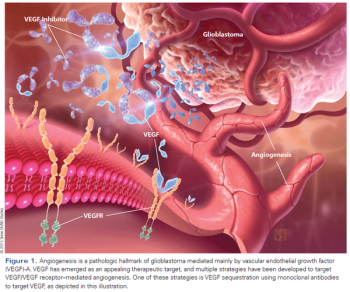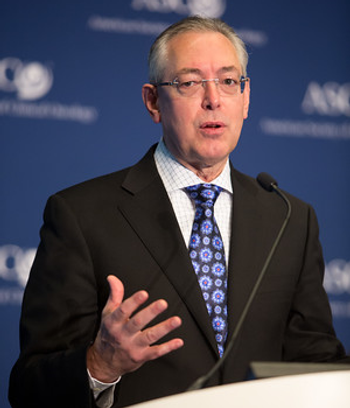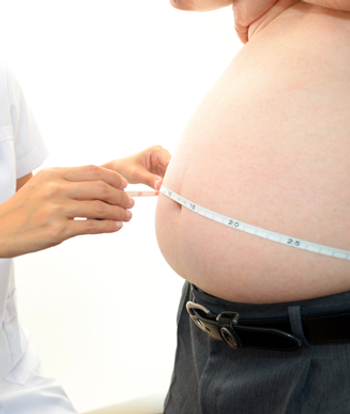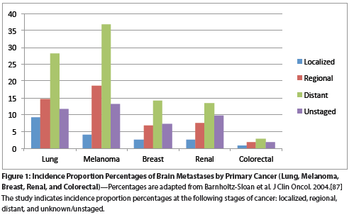
Adding rindopepimut to bevacizumab therapy was associated with improved long-term survival in patients with recurrent EGFRvIII-positive glioblastoma.

Your AI-Trained Oncology Knowledge Connection!


Adding rindopepimut to bevacizumab therapy was associated with improved long-term survival in patients with recurrent EGFRvIII-positive glioblastoma.

Despite promising progression-free survival results, the combination of bevacizumab and lomustine for the treatment of first recurrence in glioblastoma did not improve overall survival, according to findings from the phase III EORTC-26101 trial.

The US Food and Drug Administration announced an expanded indication for the Optune device to treat newly diagnosed patients with glioblastoma multiforme.

A recent study highlights factors that predict worse prognosis for patients with germ cell tumors whose cancer has spread to the brain, including the presence of liver or bone metastases, multiple brain metastases, and others.

Angiogenesis is a pathologic hallmark of glioblastoma and continues to be an appealing therapeutic target in cancer, including high-grade gliomas.

The absence of any effective combinatorial therapy in patients progressing on bevacizumab and evidence supporting both continuation and discontinuation of bevacizumab in this setting remain important areas for additional clinical trial evaluation in order to better guide our therapeutic decision making in the clinic.

A new genetic analysis found five new genetic variants that raise the risk for gliomas. One of the five was associated with a sharply increased risk for glioblastoma.

A genomic analysis of the primary tumors and brain metastases of patients has revealed potentially targetable mutations only present in the brain metastases.

A new meta-analysis found that adiposity is linked to an increased risk of meningioma, but is unrelated to glioma risk; and physical activity is linked to a lower risk for meningioma.

Gross total resection was associated with significantly lower all-cause mortality in patients with atypical and malignant meningioma, according to a new study.

Often excluded from early trials, adults with high-grade gliomas may be good candidates for solid tumor phase I studies of single agents, according to a new analysis.

Whole brain radiation therapy helps control tumor growth in patients with 1 to 3 small brain metastases, but it does not significantly extend patient survival.

Meningiomas are the most common primary brain tumor and comprise nearly one-third of all newly diagnosed primary brain tumors.

Childhood cancer patients treated with brain irradiation may be at a higher risk for developing into obese adults, according to a new study.

Conventional methods for treating brain metastasis, such as surgery, WBRT, and SRS, each compete with and complement one another. A plethora of recent studies have helped define and expand the utility of these tools.

It is time to put aside the pessimism of the past when it comes to brain metastases and embrace the wide array of clinical investigational opportunities arising in this field.

Some targeted systemic therapies have demonstrated evidence of activity in the brain-specifically in melanoma, lung cancers, and breast cancers-and these agents warrant further study in clinical trials.

There is no evidence that PCV is more effective than TMZ for the treatment of glioblastoma. However, there is unequivocal evidence that PCV is more toxic than TMZ.

In most cases, PCV chemotherapy will provide an edge in outcomes over TMZ for glioma patients, primarily because of the former regimen’s use of multiple drugs and their complementary interactions.

The US Food and Drug Administration has approved dinutuximab (Unituxin) for the treatment of high-risk neuroblastoma in pediatric patients.

Expression of the IGF2BP1 gene was associated with more advanced tumors and decreased patient survival in neuroblastoma, suggesting its prognostic value.

Researchers have shown that reprogramming T cells to target glioblastoma in mice resulted in control of these tumors.

A new study finds that childhood cancer survivors are at risk for pituitary hormone deficiencies after radiotherapy treatment to the head.

Stable, long-term survivors of low-grade glioma were able to maintain a high level of quality of life, but did experience detectable declines in certain areas.

Researchers have identified two genetic characteristics that may distinguish pediatric secondary high-grade glioma from primary high-grade glioma.